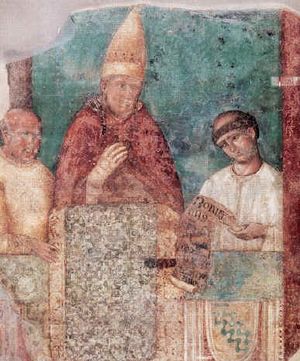جوڤاني ڤلاني
جوڤاني ڤـِلاني Giovanni Villani | |
|---|---|
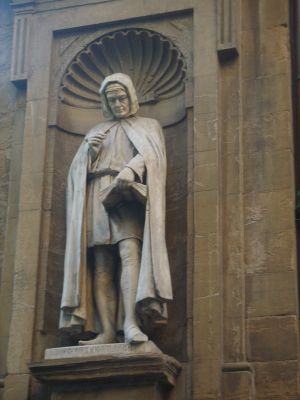 تمثال جوڤاني ڤـِلاني في Loggia del Mercato Nuovo | |
| وُلِدَ | ح. 1276 أو 1280 |
| توفي | 1348 |
| المهنة | مصرفي، مسئول، دبلوماسي، مؤرخ |
جوڤاني ڤـِلاني Giovanni Villani (ح. 1276 or 1280–1348, النطق بالإيطالية: [dʒoˈvanni vilˈlaːni])[1][2] كان مصرفياً ومسئولاً ودبلوماسياً ومؤرخاً إيطالياً من فلورنسا، وكتب كتب أكثر تواريخ العصور الوسطى الإخبارية اتفاقاً مع النزعة التاريخية الحديثة.[3] ذلك أن ڤـِلاني زار روما أيام الاحتفال بعيد عام 1300 وتأثر كما تأثر گيبون Gibbon فيما بعد بما خلفه ماضيها العظيم من أطلال خربة فخطر له في تلك اللحظة أن يسجل تاريخ المدينة، ثم رأى أن روما قد نالت كفايتها من تخليد ذكراها، فحول فكره إلى موطنه الأصلي وقرر أن "يحشد في هذا المجلد ... جميع ما وقع في مدينة فلورنسا من أحداث... وأن يقص أعمال أهل فلورنس كاملة، وأن يورد في إيجاز الشئون الهامة في سائر العالم ".[4]
حياته وعمله
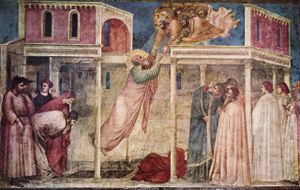
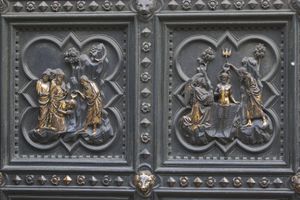
نوڤا كرونيكا
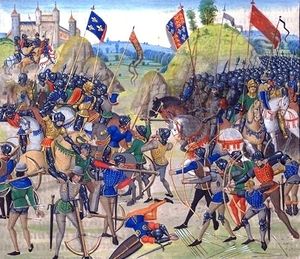
وبدأ تاريخه ببرج بابل وختمه بالأحداث التي وقعت قبيل الموت الأسود الذي مات هو فيه، وأتم القصة أخوه ماتيو Matteo وفلبو Philippo ابن أخيه حتى بلغا بها عام 1365. وكان جوڤاني حسن الاستعداد للعمل الذي اضطلع به. فقد كان ينتسب إلى أسرة ثرية من التجار، وكان متمكناً من اللغة التسكانية الخالصة، وقد طاف بأنحاء إيطاليا، وفلاندرز، وفرنسا، وعمل ثلاث مرات مختلفة رئيساً لدير، ومرة مديراً لدار سك النقود، وكان لديه إحساس غير عادي، بالنسبة لتلك الأيام، بالأسس والعوامل الاقتصادية التي تعمل في التاريخ، وكان هو أول من أدخل في قصته إحصاءات عن أحوال البلاد الاجتماعية فجعلها بذلك طريقة ممتعة. ومعظم ما في الثلاثة الكتب الأولى من "تاريخ فلورنس الإخباري " قصص خيالية، أما ما تلاها من الكتب فتحدثنا أن فلورنس وما وراءها من الأرضيين كان يسكنها في عام 1338 مائة ألف وخمسة آلاف من السكان، سبعة عشر ألفاً منهم متسولون، وأربعة آلاف يعيشون من الإعانات العامة، وأنه كان بالمدينة ست مدارس ابتدائية يؤمها عشرة آلاف ولد وبنت، وأربع مدارس ثانوية يتعلم فيها ستمائة ولد وقليل من البنات "النحو " (أي الأدب). و "المنطق " (الفلسفة). وقد فعل فلاني ما لم يفعله غيره من المؤرخين فضمن كتابه ملاحظات عما هنالك من كتب، وصور، ومبان، جديدة، حتى ليصح القول بأننا قلما نعرف أن مدينة أخرى قد وصفت جميع مظاهر حياتها وصفاً مباشراً كما وصفت فلورنس، ولو أن فلاني قد سلك كل هذه المناحي والتفاصيل في قصة واحدة من العلل، والمظاهر، والشخصيات، والنتائج لجعل من كتابه الإخباري تاريخاً حقيقياً.
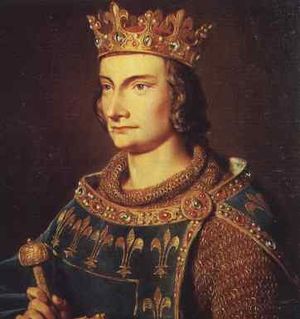
وفاته ومواصلة عمله
ويقول ماثيو ڤلاني إن ثلاثة من كل خمسة من سكان فلورنس ماتوا بين شهري إبريل وسبتمبر من عام 1348، وقدر بوكاتشو عدد من مات من أهل فلورنس بستة وتسعين ألفا(43)، وتلك بلا ريب مغالاة واضحة لأن سكان المدينة لا يكادون يزيدون وقتئذ على مائة الف.
ذكراه وانتقادات له

انظر أيضاً
الهامش
- ^ Bartlett (1992), 35.
- ^ خطأ استشهاد: وسم
<ref>غير صحيح؛ لا نص تم توفيره للمراجع المسماةencyclopedia 1517 - ^ Bartlett (1992), 35–36.
- ^ Villani, Giovanni. Encyclopædia Britannica. Retrieved March 4, 2008, from [[]Encyclopædia Britannica 2006 Ultimate Reference Suite DVD]]
- ^ خطأ استشهاد: وسم
<ref>غير صحيح؛ لا نص تم توفيره للمراجع المسماةbartlett 1992 37 - ^ De Vries (2006), 162, 173, 175.
- ^ Kleinhenz (2004), 1031.
المراجع
- Baron, Hans. "The Social Background of Political Liberty in the Early Italian Renaissance," Comparative Studies in Society and History (Volume 2, Number 4, 1960): 440–451.
- Bartlett, Kenneth R. (1992). The Civilization of the Italian Renaissance. Toronto: D.C. Heath and Company. ISBN 0-669-20900-7 (Paperback).
- Becker, Marvin B. "Florentine Politics and the Diffusion of Heresy in the Trecento: A Socioeconomic Inquiry," Speculum (Volume 34, Number 1, 1959): 60–75.
- Becker, Marvin B. "Florentine Popular Government (1343–1348)," Proceedings of the American Philosophical Society (Volume 106, Number 4, 1962): 360–382.
- Becker, Marvin B. "Notes from the Florentine Archives," Renaissance News (Volume 17, Number 3, 1964): 201–206.
- Benedictow, Ole Jørgen (2004). The Black Death, 1346–1353: The Complete History. Woodbridge: The Boydell Press. ISBN 0-85115-943-5.
- Caesar, Michael. (1989). Dante, the Critical Heritage, 1314(?)-1870. London: Routledge. ISBN 0-415-02822-1.
- Chisholm, Hugh. (1910). The Encyclopædia Britannica: A Dictionary of Arts, Sciences, Literature. Cambridge: Cambridge University Press.
- De Roover, Raymond. (2007). Money, Banking, and Credit in Medieval Bruges: Italian Merchant-Bankers, Lombards, and Money-Changers, A Study in the Origins of Banking. Cambridge: The Medieval Academy of America.
- De Vries, Kelly. (2006). Infantry Warfare in the Early Fourteenth Century: Discipline, Tactics, and Technology. Woodbridge: The Boydell Press. ISBN 978-0-85115-571-5.
- Goldthwaite, Richard A. (1980). The Building of Renaissance Florence: An Economic and Social History. Baltimore: The Johns Hopkins University Press. ISBN 0-8018-2342-0.
- Green, Louis. "Historical Interpretation in Fourteenth-Century Florentine Chronicles," Journal of the History of Ideas (Volume 28, Number 2, 1967): 161–178.
- Hunt, Edwin S. "A New Look at the Dealings of the Bardi and Peruzzi with Edward III," The Journal of Economic History (Volume 50, Number 1, 1990): 149–162.
- Hyde, J.K. "Some Uses of Literacy in Venice and Florence in the Thirteenth and Fourteenth Centuries," Transactions of the Royal Historical Society (5th series, Volume 29, 1979): 109–128.
- Kleinhenz, Christopher. (2004). Medieval Italy: An Encyclopedia. New York: Routledge. ISBN 0-415-93929-1.
- Lansing, Richard H. and Teodolinda Barolini, Joan M. Ferrante, Amilcare A. Iannucci, Christopher Kleinhenz. (2000). The Dante Encyclopedia: An Encyclopedia. New York: Garland Publishing, Inc., a member of the Taylor and Francis Group. ISBN 0815316593.
- Lavin, Marilyn Aronberg. "The Altar of Corpus Domini in Urbino: Paolo Uccello, Joos Van Ghent, Piero della Francesca," The Art Bulletin (Volume 49, Number 2, March 1967): 1–24.
- Lopez, Robert S. and Irving W. Raymond. (2001). Medieval Trade in the Mediterranean World. New York: Columbia University Press. ISBN 0-231-12356-6.
- Lucas, Henry S. "The Great European Famine of 1315, 1316, and 1317," Speculum (Volume 5, Number 4, 1930): 343–377.
- Miller, Edward (2002). Progress and Problems in Medieval England: Essays in Honour of Edward Miller. Edited by Richard Britnell and John Hatcher. Cambridge: Cambridge University Press. ISBN 0-521-52273-0.
- Molho, Anthony. "Domenico di Leonardo Buoninsegni's Istoria Fiorentina," Renaissance Quarterly (Volume 23, Number 3, 1970): 256–266.
- Najemy, John M. "Guild Republicanism in Trecento Florence: The Successes and Ultimate Failure of Corporate Politics," The American Historical Review (Volume 84, Number 1, 1979): 53–71.
- Olson, Roberta J.M. "An Early Drawing by Luigi Sabatelli Rediscovered," Master Drawings (Volume 35, Number 3, 1997): 289–292.
- Phillips, Mark. "Machiavelli, Guicciardini, and the Tradition of Vernacular Historiography in Florence," The American Historical Review (Volume 84, Number 1, 1979): 86–105.
- Ratté, Felicity. "Architectural Invitations: Images of City Gates in Medieval Italian Painting," Gesta (Volume 38, Number 2, 1999): 142–153.
- Rubinstein, Nicolai. "The Beginnings of Political Thought in Florence. A Study in Mediaeval Historiography," Journal of the Warburg and Courtauld Institutes (Volume 5, 1942): 198–227.
- Rudolph, Julia. (2006). History and Nation. Danvers: Rosemont Printing & Publishing Corp; Cranbury: Associated University Presses. ISBN 978-0-8387-5640-9.
- Selby, Talbot R. "Filippo Villani and his Vita of Guido Bonatti," Renaissance News (Volume 11, Number 4, 1958): 243–248.
- Toker, Franklin. "A Baptistery below the Baptistery of Florence," The Art Bulletin (Volume 58, Number 2, 1976): 157–167.
- Vauchez, André, Richard Barrie Dobson and Michael Lapidge. (2000). Encyclopedia of the Middle Ages. Chicago: Fitzroy Dearborn Publishers. ISBN 1-57958-282-6.
- Wicksteed, Philip H. (1906). Villani's Chronicle: Being Selections from the First Nine Books of the Croniche Fiorentine of Giovanni Villani. Translated by Rose E. Selfe. London: Archibald Constable & Co. Ltd.
- Wolfgang, Marvin E. "A Florentine Prison: Le Carceri delle Stinche," Studies in the Renaissance (Volume 7, 1960): 148–166.
وصلات خارجية
- Fordham's "Medieval Sourcebook" gives illuminating and flavorful excerpts from the Florentine Chronicle.
- Villani's Chronicles Rose E. Selfe's English translation of Dante relevant selections.
- Giovanni Villani: La Nuova Cronica – Un'opera emblematica della storiografia trecentesca Italiano: قالب:Description/i18n
- Articles with hatnote templates targeting a nonexistent page
- Language templates with no text displayed
- مواليد عقد 1270
- وفيات 1348
- مؤرخو القرن 14
- 14th-century deaths from bubonic plague
- إيطاليو القرن 14
- مؤرخون
- التاريخ الاقتصادي لإيطاليا
- تاريخ الصيرفة
- تاريخ فلورنسا
- مصرفيون إيطاليون
- تجار إيطاليون
- صيرفة العصور الوسطى
- أشخاص من فلورنسا
- جمهوريون إيطاليون
- مؤرخون إيطاليون


